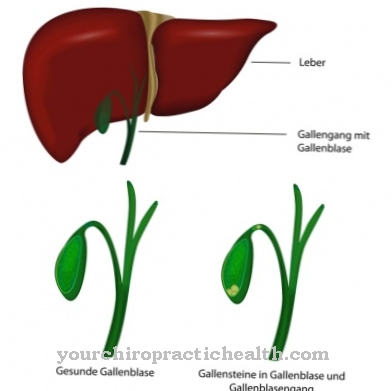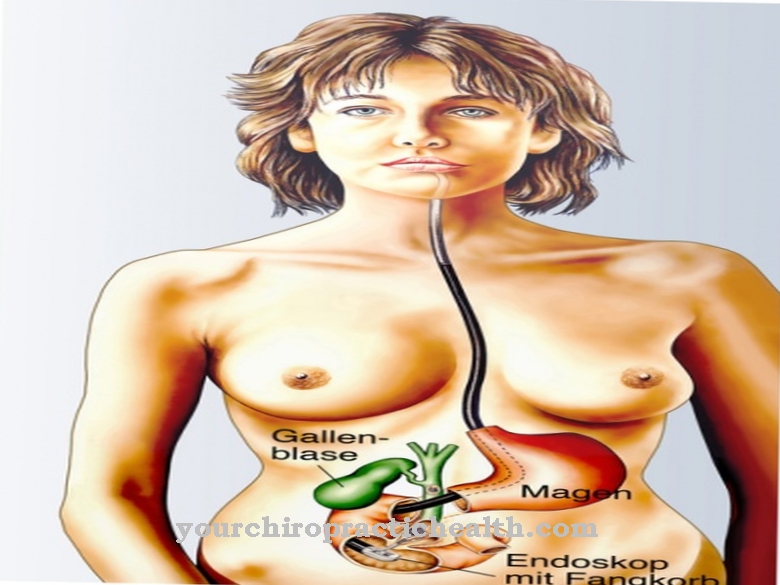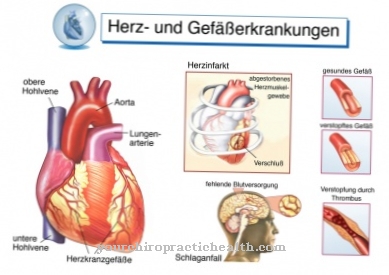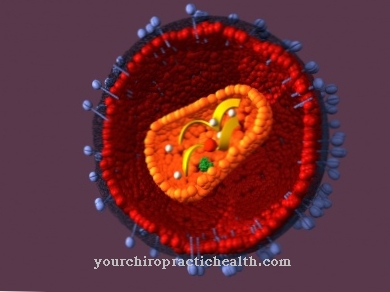Gallstones is a common disease of the gallbladder and bile ducts. The gallstones are mainly caused by solidified residues of protein and cholesterol in the gallbladder, which can then clump together in the bile duct.
What are gallstones?

Gallstones are a product of bile and about a fifth of the adult population in industrialized countries are its carriers. They are an end product of crystalline liquids that have thickened. The crystalline fluids are produced in the liver and then enter the gallbladder.
Many gallstones are not dangerous or cause pain. The only problem is when the bile meets a constriction on its way from the liver to the gallbladder. This is where the gallstones can develop, some are so small that they can be eliminated through the bladder, other stones are so large that they have to be surgically removed.
causes
The causes that lead to the formation of gallstones have not yet been fully explored. Some scientists suspect the formation of gallstones is due to a defect in a particular gene, a faulty mutation that is responsible for the formation of gallstones. Other researchers suggest that the formation of gallstones is promoted by an increased cholesterol level in connection with the decreased formation of bile.
In addition to these factors, there are several other medical reasons, such as pregnancy. A high-fat diet or a radical diet with a complete withdrawal of fats. The causes of gallstones can also be triggered by other diseases such as diabetes mellitus, obesity, thyroid problems or family pressure.
Gallstones can also be triggered after major operations, but inflammation in the liver, in the immediate vicinity or directly in the bile can lead to formation. Therefore, anyone who suffers from any of the above should have a preventative medical examination for gallstones.
Symptoms, ailments & signs

Whether and which symptoms patients with gallstones have, depends, among other things, on the size of the stones, their number and their location in the gallbladder or in the gallbladder duct. A large proportion of people with stones in the gallbladder have no or seldom symptoms.
The other sufferers have the typical symptoms of gallstone disease. These include a feeling of fullness, nausea and pain in the right upper abdomen. These complaints occur especially after high-fat meals. It becomes extremely uncomfortable when it comes to the so-called biliary colic.
The rhythmic contraction of the muscles of the gallbladder is called colic. Often there is then a stone in the bile duct. The body tries to move the stone in this way in order to remove it from the passage. The pain that occurs is classically wave-shaped, which means that it increases and decreases over the course of the day. In addition, they can radiate into the back or the right shoulder.
Another symptom of a stone in the bile duct is jaundice, known as icterus. Since the bile can no longer drain out of the gallbladder through the stone, it backs up and the typical yellow coloration of the eyes and skin develops. This backlog can also lead to inflammation of the gallbladder. This leads to fever, chills and severe pain in the right upper abdomen.
course
The course of gallstones disease varies from patient to patient. Many do not even notice that they are suffering from this disease, while others cannot walk or lie down because of the pain. After one or more gallstones have formed, gas, bloating, vomiting and sweating can occur. At the same time there is very severe pain in the upper abdomen, pressure pain.
In addition, the liver values are very high and discoloration of the urine and stool can be observed. Many complaints then predominantly occur in the evening and also at night, especially after consuming fatty dishes. If this happens, everyone should get checked for gallstones as soon as possible.
Complications
Gallstone complications are particularly acute if the bile duct is blocked by a stone. As a result, the bile is no longer able to flow unhindered into the intestine, which in turn causes a backlog in the direction of the gallbladder and liver. In some cases, the pancreas is also involved.
The accumulated secretion can cause painful inflammation. Typical symptoms of inflammation of the gallbladder (cholecystitis) are feelings of weakness, fatigue and fever. In extreme cases, the inflammation of the gallbladder leads to the fragility of the organ, which eventually ruptures. If the bile gets into the abdominal cavity as a result, there is a risk of life-threatening peritonitis (bilious peritonitis).
There is also a risk of inflammation in the liver and pancreas. Before the bile duct joins the intestine, there is an inflow from the pancreas. If the stone sits at this inflow near the intestinal outlet, the bile secretion builds up in the liver and gallbladder as well as in the pancreas.
Another complication of gallstones is jaundice (icterus). This yellowish discoloration of the skin occurs when the disturbed drainage of the bile continues for a long period of time. The white of the eyes is also colored yellow. The urine is dark in color while the stool is lighter in color. In rare cases, the gallbladder wall can be pierced by the gallstones.
When should you go to the doctor?
The following applies: if painful symptoms or discoloration of the skin, chills and fever occur, a doctor or hospital must be consulted immediately. As these symptoms keep recurring, it is essential to clarify the cause.
Pain caused by gallstones is only temporarily numbed by pain relievers and only provides symptom relief - this is no substitute for seeing a doctor. Biliary colic occurs suddenly and by reflexively wincing and writhing, for example when driving machines or automobiles, also represents a danger to others.
The clarification of other unspecific complaints (constant feeling of fullness, etc.) does not require an immediate diagnosis. If the symptoms recur, a doctor should still be consulted.
If gallstones have already been diagnosed, but they do not cause any symptoms, attention must be paid to the appearance of symptoms and the whereabouts of the stones (do the gallstones migrate? Is the bile duct partially blocked?) Must be checked at regular intervals. This means that gentle treatment can be started early if necessary. If the gallstones remain symptom-free, no treatment is necessary.
Doctors & therapists in your area
Treatment & Therapy
Treatment and therapy is different for each patient with gallstones. It depends on the severity of the disease. Gallstones that do not cause pain do not require treatment. All other patients should be treated beforehand with pain relievers, antibiotics and a special diet.
Only when the persistent pain has disappeared can thought be given to removing the gallstones. There are several options here. There is, for example, the destruction of the stones with medication. However, it must be borne in mind that the medication must be taken for up to two years. Another alternative is to smash the stones with shock waves. There is a risk that the destroyed gallstones could cause new stones to form.
The last variant is radical therapy. Here the gallstones are removed along with the gallbladder. This therapy is one of the safest ways to remove pain and prevent new growth.
Outlook & forecast
In most cases, gallstones do not cause any problems for those affected. However, if there are any complaints, surgical removal is usually uncomplicated. If the gallbladder is removed, the bile duct takes on its role as a storage location for the bile. Those affected usually only have symptoms for a few days from the operation. After that they are usually completely symptom-free.
Drug dissolution of the gallstones is usually also uneventful. However, the recurrence rate is relatively high for all treatment options. Even after removal of the gallbladder, new gallstones form again in 30 to 50% of cases within five years. With drug treatment, the risk is even greater.
Gallstones often go unnoticed because they do not cause any symptoms. However, if they become symptomatic, they should be removed. They increase the risk of developing rare cancers such as gallbladder or bile duct cancer.
In a few cases they can take a position by which they close the main bile duct. The bile cannot drain away, so that a life-threatening backwater forms. In addition, in rare cases, gallstones can pierce the gallbladder wall. Bile could thus migrate into the abdomen and cause peritonitis. Treatment is urgently recommended to avoid such complications.
Aftercare
If the gallstones have loosened through medication or even by themselves, no further follow-up is necessary. If not, possible causes need to be diagnosed and treated. First and foremost, the patient must take care of himself and otherwise adhere to the doctor's guidelines regarding diet and physical activity.
After the gallstone operation, pain and tiredness may initially persist. As part of the aftercare, the doctor will check the surgical wound and, if necessary, also check the bile duct and gallbladder artery. In the first few hours after the procedure, the patient is given painkillers, first by drip and later as tablets.
If no complications are found, the hospital can be left after a few days. At home, painkillers must still be taken, which should be gradually reduced according to the doctor's instructions. The magnesium supplements prescribed for flatulence may have to be taken a few days longer. The follow-up examination is carried out by the family doctor.
The doctor will ask about the findings and then carry out a physical examination and a short conversation with the patient. Remaining threads may have to be pulled. Depending on how fit the patient is, he may also need a sick leave. If the outcome is positive, a short check is sufficient. Further follow-up checks are not necessary after a successful gallstone operation.
You can do that yourself
Gallstones are only noticeable in about a quarter of all cases. The rest of the stones remain symptom-free. Therefore, they are usually only discovered by chance. This also means that there is no need to adjust behavior in everyday life and that self-help mainly consists of preventive measures, especially if there are known cases of gallstones in the family, because genetic factors definitely play a role in the formation of gallstones in the gallbladder or in the bile ducts a role.
The most important preventive measure is a healthy diet, which should also contain natural food components such as vegetables and fruits with a balanced amount of indigestible fiber. Extreme obesity, but also rapid weight loss and metabolic diseases such as diabetes are risk factors for the development of gallstones, which then mostly correspond to the category of cholesterol stones.
As soon as gallstones show symptoms that are often unspecific at first, biliary colic is the main fear. It is caused by spasmodic contraction of the muscles in the walls of the gallbladder to push the gallstone further into the bile duct and small intestine.
If biliary colic or other painful symptoms occur, a decision should be made to dissolve the stones with medication or to remove the stones mechanically through an operation or catheter. There are no further self-help measures, as biliary colic, for example, occurs in attacks and without prior notice.














.jpg)













